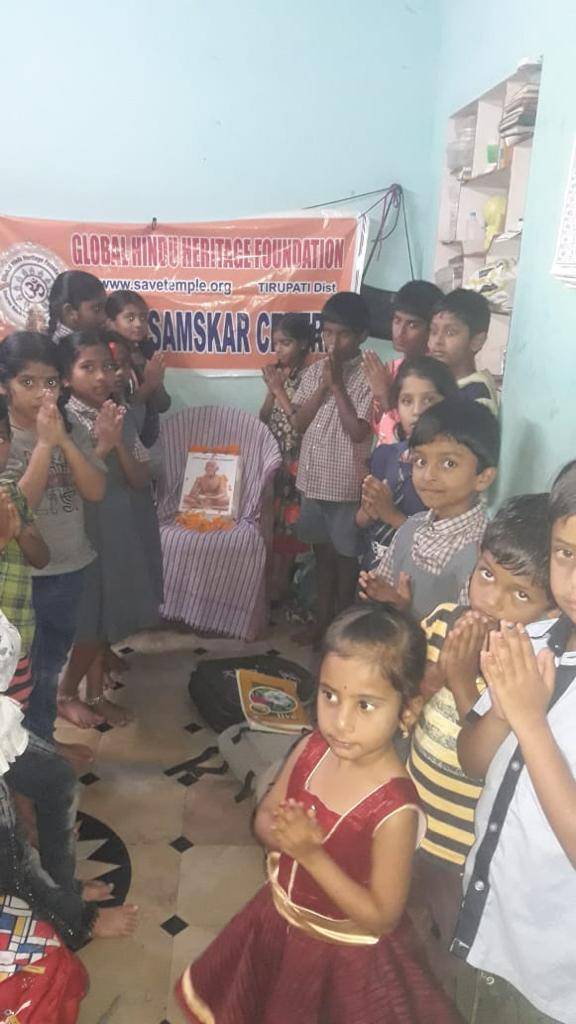[GHHF]Bala Samskar Students learned about Sri Rama Maharshi, his life, philosophy, the importance of silence, and insistence on knowing the self
 Pierre Sonnerat (1748 – 1814), French naturalist and Explorer:
Pierre Sonnerat (1748 – 1814), French naturalist and Explorer:
“.. India, in her splendor, gave religions and laws to all the other peoples; Egypt and Greece owed to her both their fables and their wisdom…. Ancient India gave to the world its religions and philosophies…. it is known that Pythagoras went to India to study under Brahmins, who were the most enlightened of human beings.”
Sri Ramana Maharshi was born on December 30, 1879, and died on April 14, 1950), born Venkataraman Iyer, was a Hindu spiritual master ("jnani"). He was born to a Tamil-speaking Brahmin family in Tiruchuzhi, Tamil Nadu. After experiencing at age 16 what he later described as liberation (moksha), he left home for Arunachala, a mountain considered sacred by Hindus. He lived on the mountain for the rest of his life
Sri Ramana Maharshi maintained that the purest form of his teachings was the powerful silence that radiated from his presence and quieted the minds of those attuned to it. He gave verbal teachings only for the benefit of those who could not understand his silence. His verbal teachings were said to flow from his direct experience of Atman as the only existing reality. When asked for advice, he recommended self-inquiry as the fastest path to moksha. Though his primary teaching is associated with Non-dualism, Advaita Vedanta, and Jnana yoga, he recommended Bhakti to those he saw were fit for it, and gave his approval to a variety of paths and practices.
He decided to leave his home and go to Arunachala. Knowing his family would not permit this, he slipped away, telling his brother he needed to attend a special class at school. Fortuitously, his brother asked him to take five rupees and pay his college fees on his way to school. Venkataraman took out an atlas, calculated the cost of his journey, took three rupees, and left the remaining two with a note which read: "I have set out in quest of my Father in accordance with his command.
Gradually, despite Sri Ramana's silence, austerities, and desire for privacy, he attracted attention from visitors, and some became his disciples. Eventually, his family discovered his whereabouts. First his uncle Nelliappa Iyer came and pled with him to return home, promising that the family would not disturb his ascetic life. Sri Ramana sat motionlessly and eventually his uncle gave up. It was at the temple at Pavalakkunru, one of the eastern spurs of Arunachala, that his mother and brother Nagaswami found him in December 1898.
Discovery by westerners
It was in 1911 that the first westerner, Frank Humphreys, then a policeman stationed in India, discovered Sri Ramana and wrote articles about him which were first published in The International Psychic Gazette in 1913.[22] However, Sri Ramana only became relatively well known in and out of India after 1934 when Paul Brunton, having first visited Sri Ramana in January 1931, published the book A Search in Secret India, which became very popular. Resulting visitors included Paramahansa Yogananda, Somerset Maugham (whose 1944 novel The Razor's Edge models its spiritual guru after Sri Ramana),[23] Mercedes de Acosta, and Arthur Osborne. Sri Ramana's relative fame spread throughout the 1940s. However, even as his fame spread, Sri Ramana was noted for his belief in the power of silence and his relatively sparse use of speech, as well as his lack of concern for fame or criticism.[24] His lifestyle remained that of a renunciate.
The 1940s saw many of Sri Ramana's most ardent devotees pass away. These included Echamma (1945), attendant Madhavaswami (1946), Ramanatha Brahmachari (1946), Mudaliar Granny, and Lakshmi (1948).[29] Sri Ramana was noted for his unusual love of creatures and plants. On the morning of June 18, 1948, he realized his favorite cow Lakshmi was near death. Just as he had with his own Mother, Sri Ramana placed his hands on her head and over her heart. The cow died peacefully at 11:30 a.m. and Sri Ramana later declared that the cow was liberated.
Sri Ramana was noted for his belief in the power of silence and relatively sparse use of speech. He led a modest and renunciate life. However, a popular image of him as a person who spent most of his time doing nothing except silently sitting in samadhi is highly inaccurate, according to David Godman, who has written extensively about Sri Ramana. According to Godman, from the period when an Ashram began to rise around him after his mother arrived into his later years, Sri Ramana was actually quite active in Ashram activities until his health failed.
Sri Ramana's teachings about self-inquiry, the practice he is most widely associated with, have been classified as the Path of Knowledge (Jnana marga) among the Indian schools of thought. Though his teaching is consistent with and generally associated with Hinduism, the Upanishads, and Advaita Vedanta, there are some differences with the traditional Advaitic school, and Sri Ramana gave his approval to a variety of paths and practices from various religions.
WE NEED YOUR HELP
1) Sponsor one Bala Samskar Kendra for $1000.00
2) Sponsor one Pracharak: In order to expand our base and hire one Pracharak, it would cost approximately $3000.00 per year. We have five anonymous donors who sponsored Assistants.
DONATIONS
PayPal Method: To donate visit our website: savetemples.org. Click on the Donate button, then press the Purpose category, and select the Ghar Waapasi Donation category.
By Zelle: ghhfusaorg@gmail.com
RUPEES, if you would like to contribute to rupees, please either call or send an email. We will call you back to give you the required information
For more information, send an Email to: ghhfusaorg@gmail.com


















 Urgent support needed for Bangladesh Hindus
Urgent support needed for Bangladesh Hindus 







